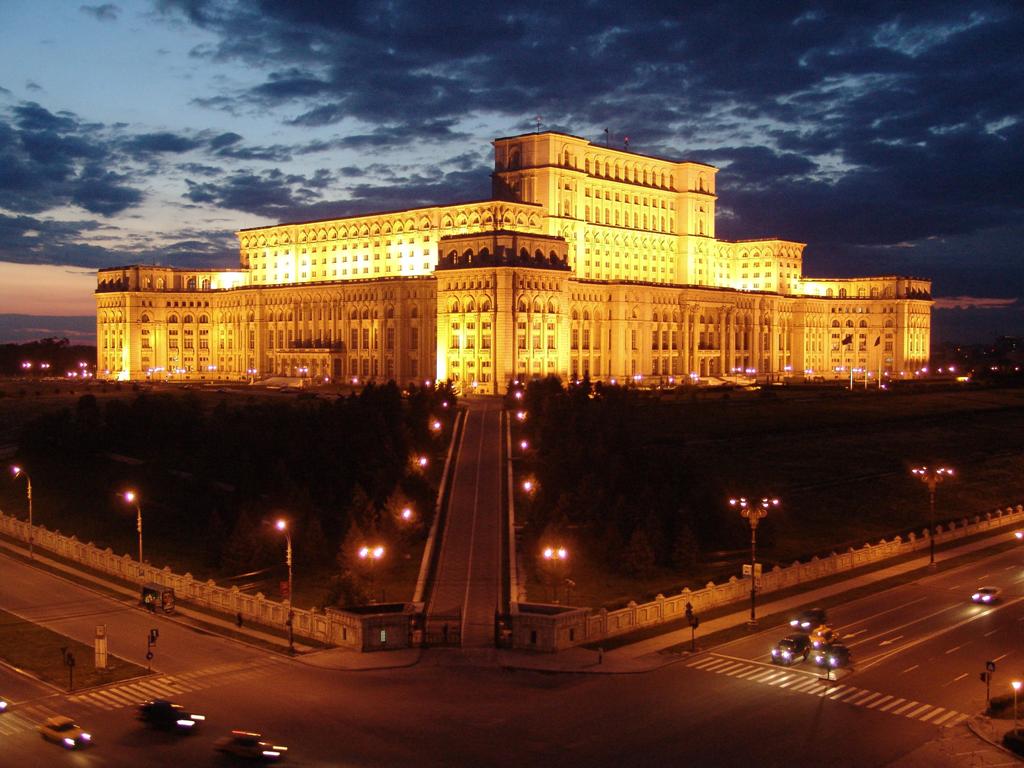- Palace of the Parliament
Infobox Historic building
name = Palace of the Parliament
"Palatul Parlamentului"
caption = The Palace of the Parliament at dusk
map_type =
latitude =
longitude =
location_town =Bucharest
location_country = ROU
architect = Anca Petrescu (chief architect)
client = p|engineer =
construction_start_date = 25 June 1983
completion_date =
date_demolished =
cost =
structural_system =
style = none (a combination of many different styles)
size = 270 m by 240 m, 86 m high
92 m under ground
1,100 rooms
12 stories tall
with four additional underground levels currently available and in use (another four in different stages of completion)The Palace of the Parliament ( _ro. Palatul Parlamentului) in
Bucharest ,Romania is a multi-purpose building containing both chambers of the Romanian Parliament. According to theGuinness Book of World Records , the Palace is the world's largest civilian administrative building, most expensive administrative building, and heaviest building.Fact|date=August 2008The Palace was designed and nearly completed by the Ceauşescu regime as the seat of political and administrative power.
Nicolae Ceauşescu named it the House of the Republic ("Casa Republicii"), but many Romanians call it the People's House ("Casa Poporului"). [cite news | title=Palatul Parlamentului / Casa Poporului | publisher=miculparis.ro | url =http://www.miculparis.ro/turistice/turul_bucurestiului/casa_poporului.html | pages = 1 | language = Romanian] After theRomanian Revolution of 1989 , completing the building was no longer a priorityFact|date=February 2008, and the building remains unfinished.Description
The Palace measures 270 m by 240 m, 86 m high, and 92 m under ground. It has 1,100 rooms, 2 underground parking and is 12 stories tall, with four additional underground levels currently available and in use, with another four in different stages of completion.
The structure combines elements and motifs from multiple sources, in an eclectic neoclassical architectural style. The building is constructed entirely of materials of Romanian origin. Estimates of the materials used include one million cubic meters of
marble fromTransylvania , most fromRuşchiţa ; 3,500 tonnes of crystal — 480 chandeliers, 1,409 ceiling lights and mirrors were manufactured; 700,000 tonnes ofsteel andbronze for monumental doors and windows,chandelier s and capitals; 900,000 m³ of wood (over 95% domestic) forparquet andwainscotting , includingwalnut ,oak , sweet cherry,elm ,sycamore maple ; 200,000 m² ofwooll encarpet s of various dimensions (machines had to be moved inside the building to weave some of the larger carpets);velvet andbrocade curtains adorned with embroideries and passementeries insilver andgold . [ [http://www.fotocommunity.de/pc/pc/cat/2861/display/3175968 Romania: Inside the Palace of Parliament ] ]Construction
Built on the site of a hill variously known as Spirii Hill, Uranus Hill, or Arsenal Hill, which was largely razed for this
megaproject , the building anchors the west end ofUnirii Boulevard andCentrul Civic . Constructing the Palace and Centrul Civic required demolishing much of Bucharest's historic district, including 19 Orthodox Christian churches, six Jewish synagogues, three Protestant churches (plus eight relocated churches), and 30,000 residences.Fact|date=October 2007Construction began in 1983; the
cornerstone was laid on June 25, 1984. The building was intended to house all four major state institutions (similar to what theHouses of Parliament operated like):
* "Preşedinţia Republicii" (the Presidency of the Republic);
* "Marea Adunare Naţională" (theGreat National Assembly , the parliament);
* "Consiliul de Miniştri" (the Government);
* "Tribunalul Suprem "(the Supreme Court).This explains the building's rectangular shape.At the time of
Nicolae Ceauşescu 's 1989 overthrow and execution, the building's structure and design were complete. Subsequently, many of the furnishings were never installed, and the last three basement levels and a large clock tower (that would have displayed the official Romanian time) were never finished. During the regime change, the new leaders of Romania referred to the building as the House of Ceauşescu, to highlight the excessive luxury in which Ceauşescu would have lived, in stark contrast to the squalor and poverty endured by many people living in the surrounding neighbourhoods.Parts of the building (some of the west wing, some of the east wing, parts of the second floor, basement 3 and everything below) have yet to be completed. Currently, a new underground car-park is being built inside a former stadium, currently used as a warehouse, which was covered during the construction of the palace. Tunnels linking
13 Septembrie Avenue with the basement of the building will be built.History since 1989
Since 1997, the building has housed Romania's Chamber of Deputies, which had previously been housed in the Palace of the Patriarchy; the Romanian Senate joined them there in 2005, having previously been housed in the former Communist Party Central Committee building. The Palace also contains a massive array of miscellaneous conference halls, salons, etc., used for a wide variety of other purposes.
In 2002,
Costa Gavras shot scenes of "Amen. " in the Palace to represent the Vatican palaces.In 2003-2004 a glass annex was builtFact|date=February 2008, alongside external elevators. This was done to facilitate access to the National Museum of Contemporary Art (MNAC) opened in 2004 inside the west wing of the Palace of the Parliament, and to the Museum and
Park of Totalitarianism and Socialist Realism , also opened in 2004.The
cafeteria for use of the legislators has been refurbished .Also in the building is the headquarters of theSoutheast European Cooperative Initiative (SECI), an organization focused on regional cooperation among governments against cross-border crime.There are public tours organized in a number of languages.
In 2008, the Palace hosted the 20th NATO summit.
Picture gallery
References
External links
* [http://www.cdep.ro/pls/dic/site.page?id=27 Romanian Chamber of Deputies page about the Palace]
* Cristina Hanganu-Bresch, [http://web.archive.org/web/20060219232635/http://www.fantasypieces.org/files/Research/CasaPoporului.pdf People's House - The Building and Rebuilding of Romanian National Consciousness] (PDF )
* [http://www.cdep.ro/cic/photohalls.html Photo gallery on the Chamber of Deputies website]
* [http://oasis.halfmoon.jp/extphoto/romania_main.html Photo collection] - numerous photos of various parts of Romania, including an extensive set with the Palace of the Parliament. Captioned in a mix of Japanese and Romanian people.
* [http://maps.google.com/?t=k&ll=44.427942,26.088216&spn=0.010451,0.020127&om=1 The Palace on satellite photo from Google Maps]
Wikimedia Foundation. 2010.
